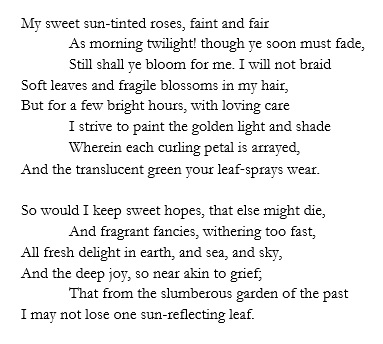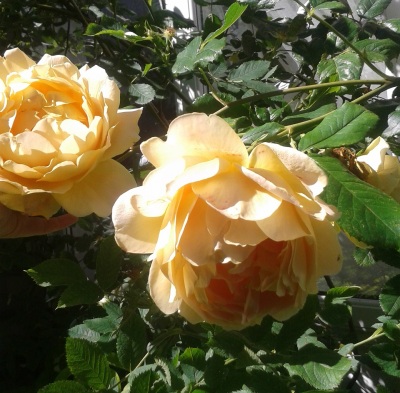This sonnet marks a shift in tone from ‘Yellow Roses’, as Naden highlights that the first half of the year has now passed and the seasons are now waning. The joy taken in summer flowers has quickly been lost. Picking up on the line ‘fragrant flowers, withering too fast’ in the preceding sonnet, she describes summer as characterised by ‘Scorched buds and flowers, that tell what might have been’, undermining spring’s promise of lush new life.
As this attests, Naden is rarely able to maintain an unwaveringly positive tone; death (and analogously, winter) is always on the horizon, the necessary corollary of life (and spring). Summer thus manifests in ‘dust and blight’, and leaves only the ‘barren splendours of July’. It is redolent of missed opportunities and hopes undermined by realities – ‘The promised loveliness’ never materialises, and Naden wistfully dwells on ‘what might have been.’
The ‘waves that rise and fall’, describe the shimmering heat and recall the movement of leaves in spring breezes such as those of ‘March, 1878’ and ‘April, 1879’. And yet this phrase also gestures towards the rise and fall of iambic pentameter that underlies the sonnet form; Naden therefore draws out how poetic metre echoes and reflects the rhythms she finds in the natural world around her.
After the volta a ray of hope is introduced: the scorching sun brings skies of ‘tender blue’, ‘the red leaves bud anew’, and ‘Fresh, brilliant hope bursts forth’. It is interesting that Naden chooses to frame this as ‘glowing speech’, again likening her description of nature to the textual mode that she employs to capture it. Nevertheless, the octave’s final line ends with ‘die’, which the rhyme scheme pairs with the very word ‘July’, demonstrating her realist approach to natural cycles (although in a somewhat heavy-handed way).
Her fixation upon this perhaps seems odd for a twenty-year-old, privileged woman with many opportunities ahead of her. While I don’t wish to offer a biographical reading of these sonnets, it may be relevant to note that her mother died when Naden was an infant and she was brought up by grandparents who were nearing the ends of their lives, making her intimate with the realities of loss and old age. In addition, her move away from organised (though dissenting) religion towards pantheistic and then agnostic philosophies encouraged her to dwell on what might be termed ‘The Big Questions’.
As is clear in this poem, and the Year in Sonnets sequence as a whole, Naden is preoccupied with the changeful cycling between life and death that is mirrored in the seasons. The sonnet form itself supports this perspective, as we find its unity and balance is an outcome of two distinct but interdependent stanzas. In this way, we are encouraged by Naden to identify and reconcile ourselves with the reciprocal relationship between natural opposites, and seek to find and accept the decay already visible in summer that heralds inevitable winter.




















